Art And Architecture Of The Igbo People - Culture - Nairaland
Nairaland Forum / Nairaland / General / Culture / Art And Architecture Of The Igbo People (67794 Views)
The Art And Architecture Of Yorubaland! / Benin Art And Architecture / Show Pictures Of Africas Art And Archaeological Treasures (2) (3) (4)
(1) (2) (3) (4) (Reply) (Go Down)
| Art And Architecture Of The Igbo People by Crayola1: 12:37am On Oct 16, 2011 |
I think there was a thread on this once but I was unable to find it, so I decided to restart one again  Figure Representing Ugonachonma (The Eagle Seeks Out Beauty)      The description that went along with it: Origin: Igbo Tribe, Nigeria Composition: wood, pigment dyes (including kaolin, indigo, and red ochre), glass, natural materials One of the most important wooden pieces in the collection, this very old figure has significant evidence of age and use consistent with the ritual utilty the piece has within its tribal cultural context. This piece is from the central Igbo region and represents Ugonachonma (translated as “The Eagle Seeks Out Beauty”). It possesses a sophisticated, attractive coiffure (with reflective mirrored-glass inserts common to young women of marrying age from wealthy families) and a long neck (considered a feature of a beautiful young woman), with scarification (also for beauty). The white pigment on the legs is thought to “exaggerate the Igbo preference for light-colored skin and evokes the practice of washing dark skin with a chalky solution to create a contrasting ground for indigo uli patterns.” Following in the background given on this piece, “Ugonachonma served as centerpieces for largely secular-age grade dances”. Young, beautiful maidens are thought to be associated with eagles, as the maidens are praised as “eagle’s kola” after the prized kola nut shared at Igbo ceremonies (Visona, A History of Art In Africa, p. 289). The Igbo occupy the present east central state of Nigeria and parts of the present mid-western state. The Igbo speak a common language, but with different dialects. Most Igbo traditionally live in scattered villages, which form the basic social units, cosmologically, they believe in the existence of the Supreme Being whom they call Chuku or Chineke. There are other minor deities under him, Anyanwu (The Sun), Iwa (The Sky) Ale (The Earth). Ale, the most important minor deity, is connected with ancestors-Noiche and Ajoku, the divinity associated with Yams. The ancestors usually appear as masked dancers (Mmuo) who dance during festivals and funerals (Ref: Lois Woods Museum). Crest Mask with Human and Animal Elements      Origin: Igbo Tribe, Nigeria Composition: wood, rattan, pigment, nails Age: early 20th century This head crest is an enigma. The carving style, especially the delicate human face, suggests that it was made by the Igbo, but the cap-style headdress is not part of the Igbo masking tradition. It most likely comes from southern Igbo territory, where influence from the Idoma (the Igbo’s southern neighbors) would be most prevalent. The Idoma carve crest masks (similar to this piece, with distinctly different facial features) called Eku, that combine the elements of many animals with human features. An important related piece from the Igbo was published in "Nigerian Art: The Meneghelli Collection." Pair of Large Seated Ntekpe Figures     Origin: Igbo Culture, Nigeria Composition: terracotta, pigment Age: 20th century These ntekpe figures were originally part of a family shrine that honored one of the many Igbo deities. Most Igbo households would erect at least one such shrine, usually near the entrance to the Home. The ntekpe figures were considered "children of the shrine" and its deity. Their function was to protect the inhabitants of the house and to help when needed. Covered Tekpe Bowl with Two Snakes   Origin: Igbo-Izzi Culture, Nigeria Composition: terracotta, pigments, libations Age: 19th century The northeastern area has a divination system and shrine complex quite distinct from those of other Igbo areas. Many family compounds have at least one shrine containing ceramic vessels and figures. The shrines are placed at compound entrances, outside houses, in domestic gardens, as well as in small sheds of their own. The Tekpe, are considered "children" of the shrine and its deity, and are there to help and protect it. Tekpe bowls are depicted with great variety. Some show human faces with an open mouth, others depict animals and miniature figures. This bowl shows two entwined snakes covering the lid, under which magical substances would have been placed (Ref: Cole, "Igbo Arts: Community and Cosmos"; Neyt, "The Arts of the Benue"; Schaedler, "Earth and Ore"  . .This piece was thermoluminescence tested by Laboratory Ralf Kotalla (Germany), and found to be authentic, having been fired (created) between 1876 and 1920 A.D. Tekpe Bowl with Slithering Snakes     |
| Re: Art And Architecture Of The Igbo People by Crayola1: 1:10am On Oct 16, 2011 |
Igbo Masks   agbogho mmwo, of hollowed helmet-like form, the stylized facial features including a pierced, diamond-shaped mouth beneath the sharp nose bisecting the slit eyes and decorated with linear and circular scarification, the whole surmounted by a complex openwork coiffure comprised of three arching bands punctuated by circular and cylindrical motifs; varied aged surface with areas of red, white, black and blue pigment. This mask represents numerous attributes of the ideal of female beauty among the Igbo. Worn each year for 'The Fame of Maidens' ceremony, it is intended to instruct youths in attitudes necessary for moral as well as physical beauty. Physically, height and litheness, good posture, a straight nose and small mouth are all ideals. These traits are physical indices to the moral ideals of purity, obedience, good character and generosity (Cole and Aniakor 1982: 121).  African art and masks of the Igbo (Ibo) people of Nigeria. This hand-carved wooden mask from the Igbo people is 14 inches tall, and 8.75 inches wide. 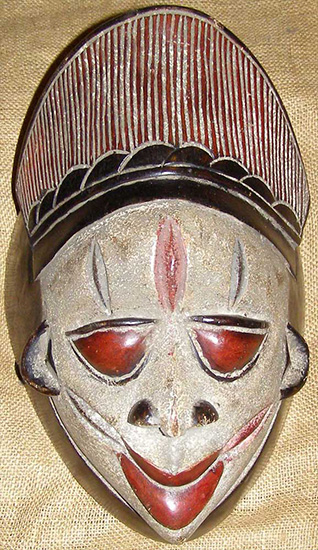 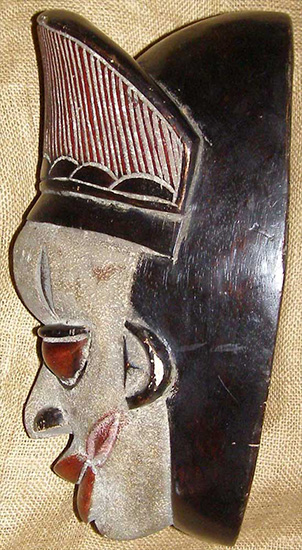 Mask 25 18.5"high x 13"wide x 9"deep 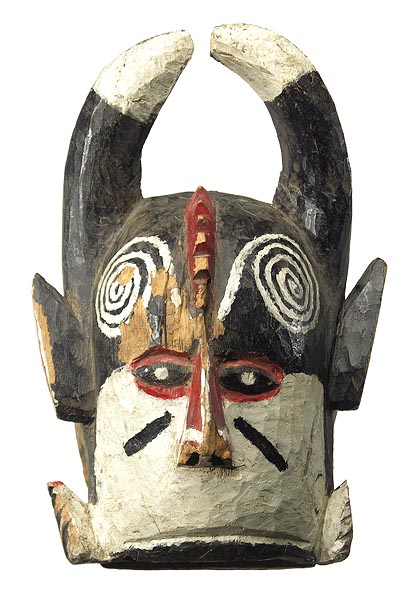 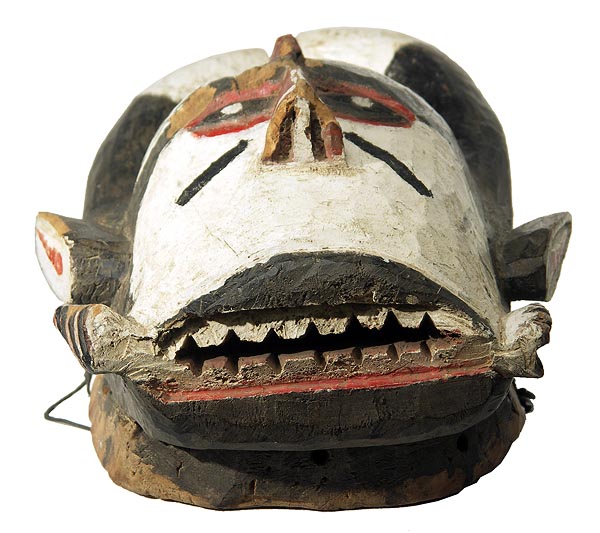 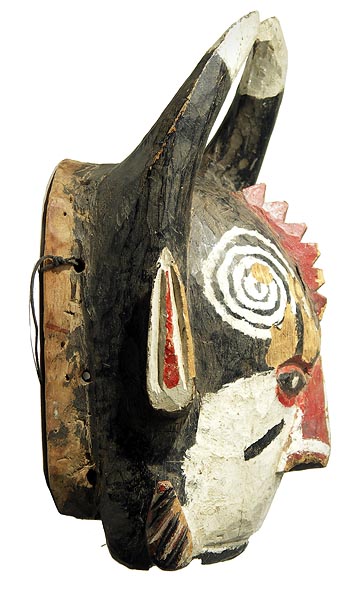 Acali mask Igbo people, Afikpo District, Nigeria 11.5 inches, wood, pigment and plant fiber This is a face mask that is commonly used in okumkpa performances in the Igbo town of Afikpo and surrounding villages in southeastern Nigeria. Okumkpa is a theater tradition staged after the Dry Season Festival. Among the Afikpo Igbo, putting on a mask transforms the performer into a spirit (mma). Such masks are generally associated with a deity of the secret society called egbele, but the spirit of the deity is not perceived as residing in the mask but as remaining in the sacred bush--the mma is viewed as a manifestation of it. Ottenberg (1975: 18-19) informs us that the acali mask is generally worn by the youngest players in okumkpa performances and that it is one of the least common Afikpo masks. It does not appear to have been used.  IGBO MASK / HEADDRESS 1, 39" [img]http://www.hamillgallery.com/IGBO/IgboMasks/IgboMask01JPG[/img] Igbo maiden spirit mask Height 17 1/4 in [img]http://uima.uiowa.edu/assets/Uploads/_resampled/SetWidth500-2006377small.jpg[/img] Igbo Mask 19th Century [img]http://migrationstoriesofnigerianigbo.files./2010/07/igbo-mask-19th-century.jpg[/img] |
| Re: Art And Architecture Of The Igbo People by Crayola1: 1:18am On Oct 16, 2011 |
Architecture Igbo Family Compound  Mbari Houses [img]http://content.lib.washington.edu/cgi-bin/showfile.exe?CISOROOT=/buildings&CISOPTR=6050[/img] [img]http://content.lib.washington.edu/cgi-bin/showfile.exe?CISOROOT=/buildings&CISOPTR=6077[/img] Family Home 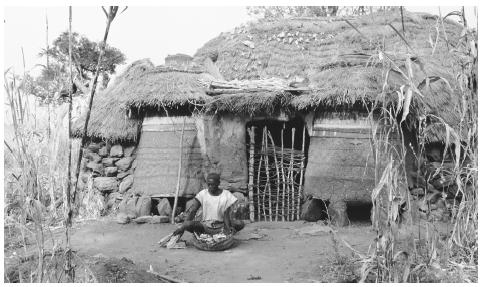 House in Owerri Figure of a motor transport magnate and symbols of his (horse) power [img]http://mccoy.lib.siu.edu/jmccall/jones/igbo/misc3.JPG[/img] Gate  Tower [img]http://2.bp..com/_jeBv7EEofYQ/TLvDiw1p7LI/AAAAAAAAAKQ/QUdZLOjpDz0/s1600/Dike%27s+Tower.png[/img] Mud Molding in Onitsha [img]http://2.bp..com/-w65Fym20lzc/Tpb0vqBb_cI/AAAAAAAAAok/IfCLviEPiY4/s1600/models.jpg[/img] Chi Shrine [img]http://2.bp..com/-yPZH6TrB2Fo/TpbmMQtQyFI/AAAAAAAAAn0/sFFj5AEpXWI/s400/chi%2Bshrine.jpg[/img] Mbari plan [img]http://4.bp..com/-SPANqYqLfiI/TnaAJJjTfbI/AAAAAAAAAmc/QZm_wuIggGI/s400/mbari-plan.jpg[/img] Carved door [img]http://2.bp..com/-HSTaxH44VbQ/TnZ-SKuRM4I/AAAAAAAAAmU/tLl7Ozux9CQ/s400/doors-mud.jpg[/img] Nri door [img]http://4.bp..com/-IbGXoy2KYI8/TnZYxkXViZI/AAAAAAAAAl0/PBzpZbhCrD8/s400/nri.jpg[/img] Decoration of Ibo Houses [img]http://1.bp..com/-qqWJHjUaX08/TWAuPFbypEI/AAAAAAAAAPo/YuQchCwFB04/s400/Note%2Bon%2BIbo%2BHouse%2B2.jpg[/img] [img]http://2.bp..com/_jeBv7EEofYQ/TVLtl3l6HBI/AAAAAAAAAPc/31MZW_rBE18/s400/Note%2Bon%2BIbo%2BHouse.jpg[/img] |
| Re: Art And Architecture Of The Igbo People by aljharem3: 1:20am On Oct 16, 2011 |
Igbo-Ukwu Culture Bronze Bowl, ca. 9th or 10th century A.D.   |
| Re: Art And Architecture Of The Igbo People by aljharem3: 1:22am On Oct 16, 2011 |
Ojionu  |
| Re: Art And Architecture Of The Igbo People by lakal(m): 1:25am On Oct 16, 2011 |
Great thread. Traditional thatching being done in Igboland.  |
| Re: Art And Architecture Of The Igbo People by aljharem3: 1:26am On Oct 16, 2011 |
Uli is an expression of the people’s capacity for creative design, which is firmly rooted in their myths and their experience of life in the past, present and future. At its best, it is an expression of their synthetic present, the epic of their search for a new order in the contemporary world. It is my traditional art style, which I have fallen in love with all over again and it is a privilege to share uli with you in my works. It has been shown that the knowledge of uli motifs and symbols and their application enables one to identify the traditional Igbo artifacts, giving validity to the people’s aesthetic intelligence and judgment. This culture is one of the first known cultures of the world in the recorded archeologically facts to have done bronze casting. (Igboukwu bronze). Uli symbols may be said to show graphically how the organic forms grow outwards from the core of those elements to point, line, triangle, square and circle that are universal to the concentric circle at the periphery, which contains reflections of everyday world as seen by the artists. Just as the inner circle reflects the uncommon reality or ritual reality of the cultural existence, so the outer circle is in contact with the human and ecological reality, which it expresses. Artistic activities at Enugu formed part of the early post-1960 independence developments in the country. There was the growing local and international popularity of Nigerian novelists, dramatists, poets, literary critics, architects, artists, and musicians, and scholars. Interesting collaborations took place among those in the literary performing, and visual arts, particularly in southern Nigeria. The efforts and artistic lives of these minds sowed a flourishing seed for an uncommon global harvest. I give thanks to God for these great minds, your outstanding contributions will not be forgotten. Uli creations relied heavily on drawing skills whose content is based largely on Igbo culture, particularly female body and wall painting called uli and on Igbo tales, ceremonies, and beliefs. The revival of interest in uli through contemporary art had begun with Uche Okeke in the 1960s, when Nigeria's independence produced a growing sense of freedom from colonial restraints on cultural tradition. It fully developed among teachers and students in the 1970s at the University in Nsukka and was linked to renewed interest in Igbo culture after the destructive Biafran War. Traditional uli motifs, now rarely painted on human bodies or walls, have a strong linear, often curvilinear, quality. The art makes use of contrasts between positive and negative space, its images at times appearing as sky constellations. Uli’s lyrical qualities express harmony and brevity. It is art style that has often been created in freedom and spontaneity. “Uli is a pride heritage". Uli motifs generally refer to images of everyday Igbo life, farm and cooking tools, pots, plants, birds, animals, the sun, the moon, and the kola nut, though some are pure design. For ceremonial occasions and important events, skilled Igbo female artists painted uli to add beauty to the human body and the walls of buildings and compounds. Uli has made her way in modern social settings; on sculptural surfaces and on paper, board, and canvas, framed and hung on walls in homes, institutions, and galleries of the world. Magic of Uli Lines, which is an extended dot or a moving point, has very many possibilities, particularly, the quickly drawn one. My drawing explores the evocative and lyrical possibilities of line and derives from Uli. The Uli artist works spontaneously whether on the human body or the wall.  |
| Re: Art And Architecture Of The Igbo People by aljharem3: 1:27am On Oct 16, 2011 |
 |
| Re: Art And Architecture Of The Igbo People by aljharem3: 1:28am On Oct 16, 2011 |
Igbo Idoma Wooden Dance Mask  |
| Re: Art And Architecture Of The Igbo People by aljharem3: 1:30am On Oct 16, 2011 |
Male carving at one end of large ikoro drum, Ohafia [img]http://mccoy.lib.siu.edu/jmccall/jones/igbo/ikoro1.JPG[/img] |
| Re: Art And Architecture Of The Igbo People by aljharem3: 1:31am On Oct 16, 2011 |
Female carving at other end of large ikoro drum, Ohafia [img]http://mccoy.lib.siu.edu/jmccall/jones/igbo/ikoro2.JPG[/img] |
| Re: Art And Architecture Of The Igbo People by lakal(m): 1:32am On Oct 16, 2011 |
My favorite Igbo-Ukwu artwork: the roped pot. West African peoples were producing aesthetically wonderful art over 1,000 years ago.   Igbo-Ukwu (9th Century AD). Bronze pot on a stand roped together. |
| Re: Art And Architecture Of The Igbo People by aljharem3: 1:32am On Oct 16, 2011 |
| Re: Art And Architecture Of The Igbo People by aljharem3: 1:33am On Oct 16, 2011 |
| Re: Art And Architecture Of The Igbo People by aljharem3: 1:34am On Oct 16, 2011 |
| Re: Art And Architecture Of The Igbo People by aljharem3: 1:34am On Oct 16, 2011 |
| Re: Art And Architecture Of The Igbo People by aljharem3: 1:35am On Oct 16, 2011 |
| Re: Art And Architecture Of The Igbo People by aljharem3: 1:37am On Oct 16, 2011 |
Alusi Tutelary and fertility juju, Ishieke, Isu [img]http://mccoy.lib.siu.edu/jmccall/jones/igbo/arunsi6.JPG[/img] |
| Re: Art And Architecture Of The Igbo People by aljharem3: 1:38am On Oct 16, 2011 |
Alusi Tutelary and fertility juju -- Ishieke, Isu amazing!!!! [img]http://mccoy.lib.siu.edu/jmccall/jones/igbo/arunsi7.JPG[/img] |
| Re: Art And Architecture Of The Igbo People by aljharem3: 1:38am On Oct 16, 2011 |
Alusi Tutelary and fertility juju -- Ishieke, Isu [img]http://mccoy.lib.siu.edu/jmccall/jones/igbo/arunsi8.JPG[/img] |
| Re: Art And Architecture Of The Igbo People by aljharem3: 1:39am On Oct 16, 2011 |
Ibudu Mud shrine made to protect and prosper a household [img]http://mccoy.lib.siu.edu/jmccall/jones/igbo/arunsi9.JPG[/img] |
| Re: Art And Architecture Of The Igbo People by aljharem3: 1:40am On Oct 16, 2011 |
Alusi With Ikenga and other ritual objects, Orsu, West Isuama Igbo [img]http://mccoy.lib.siu.edu/jmccall/jones/igbo/arunsi12.JPG[/img] |
| Re: Art And Architecture Of The Igbo People by aljharem3: 1:41am On Oct 16, 2011 |
| Re: Art And Architecture Of The Igbo People by aljharem3: 1:41am On Oct 16, 2011 |
| Re: Art And Architecture Of The Igbo People by aljharem3: 1:42am On Oct 16, 2011 |
Alusi Shrine of a tutelary deity of one of the adjacent villages erected on the road from Udi to Ngwo on the escarpment above Enugu township, Obioma town, Abaja, Northern Igbo [img]http://mccoy.lib.siu.edu/jmccall/jones/igbo/arunsi20.JPG[/img] |
| Re: Art And Architecture Of The Igbo People by aljharem3: 1:53am On Oct 16, 2011 |
| Re: Art And Architecture Of The Igbo People by aljharem3: 1:53am On Oct 16, 2011 |
| Re: Art And Architecture Of The Igbo People by aljharem3: 1:54am On Oct 16, 2011 |
Shrine Object Uvo. Ibo, Nigeria. 19th Century. This is where primitive art meets modern abstraction. The North West IBO people create these shrine objects called Uvo; related to Ikenga, but Uvo are extremely rare. The finely carved head that sits on this M like design is very expressive. This design could also be looked at as a surreal stylized human body. Carved from hardwood with an encrusted surface from years of sacrifices; this is a truly magnificent Nigerian sculpture. This object stands 9 inches tall and 12 inches long.    |
| Re: Art And Architecture Of The Igbo People by aljharem3: 1:56am On Oct 16, 2011 |
North east Igbo art  |
| Re: Art And Architecture Of The Igbo People by aljharem3: 1:58am On Oct 16, 2011 |
The amazing work of art in Igbo ijele [img]http://t2.gstatic.com/images?q=tbn:ANd9GcTxtnZk1_WuGeAmZLhJc-yV-K-C2XBaDTkV_lXQ19Dj6tZSAEyT1g[/img] |
| Re: Art And Architecture Of The Igbo People by aljharem3: 1:59am On Oct 16, 2011 |
funeral cloth 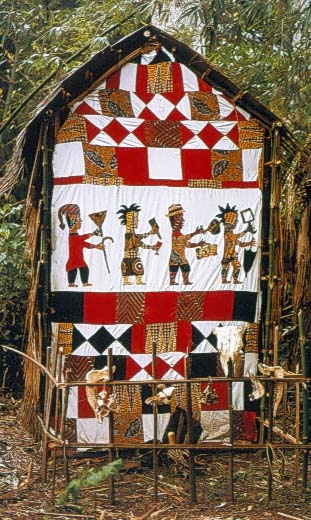 |
How A Tribe, Kilba, In Adamawa Bury Their Dead (Photos) / Suri Tribeswomen Of Ethiopia Who Wear Large Lip Plate To Determine Worth In Cows / Michael Olabamiji Fakeye's Corpse Made To Stand To Snap With Family In Osun
(Go Up)
| Sections: politics (1) business autos (1) jobs (1) career education (1) romance computers phones travel sports fashion health religion celebs tv-movies music-radio literature webmasters programming techmarket Links: (1) (2) (3) (4) (5) (6) (7) (8) (9) (10) Nairaland - Copyright © 2005 - 2024 Oluwaseun Osewa. All rights reserved. See How To Advertise. 52 |